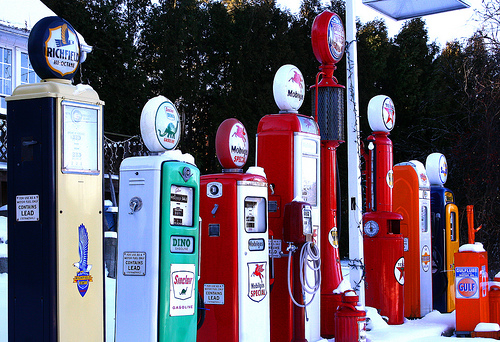The decision of the Obama Administration to embrace stronger fuel economy standards by 2016 is drawing praise from environmentalists but fire from auto analysts who say it will add to Detroit’s woes. The decision to accelerate fuel economy comes on top of a variety of policy proposals to address climate change, the auto industry and transportation including the cap and market bill that was the subject of House hearings yesterday, the deliberations of the Auto Task Force over GM’s fate, replenishing the Highway Trust Fund and a proposal to offer clash for clunkers also in legislation working its way through Congress. Here are my thoughts how higher fuel economy standards fit into the bigger picture.
First, fuel economy standards are among the least precise tools for addressing climate change. The reason? Fuel economy is the mathematical equivalent of lower gas prices insofar as its allow consumers to drive more for less. While it is therefore good for motorists’ pocket books, its impact on emissions is ambiguous. If you believe that people drive a certain amount each day and never vary that amount–then higher fuel economy translates directly to lower emissions. However, if you believe that people drive more when gas costs less in other words that gas usage is price elastic–then higher fuel economy leaves more money in your pocket but does little to reduce emissions. Last year’s falloff in driving when oil prices spiked (as well as numerous studies) suggests that gas use is price elastic. As a result, the primary impact of higher fuel economy is likely to be what economists call an improvement in consumer welfare but not a large reduction in gas emissions.
Second, higher fuel economy–by lowering the cost of driving a mile–also runs counter to the idea of making carbon more expensive–the idea behind carbon tax proposals and the cap and market legislation debated yesterday.
Third, fuel economy standards like gas prices are likely to impact the quantity of gasoline consumed. In fact that is the goal. To the degree they lead to less gas consumption, they lead to fewer gas taxes collected. Since the Highway Trust Fund which finances not only roads but a large share of mass transit in America relies on gas taxes, higher fuel economy standards may reduce money available for transportation. Later this year, Congress will try to fix the finances of the Highway Trust Fund. But we should be mindful that improving fuel economy cuts in the opposite direction of two other policy ideas: making carbon more expensive and replenishing infrastructure funds.
Finally, there is the cost to the auto industry of making cars more fuel efficient. The Auto Task Force has adopted fuel economy as an unofficial goal and suggested Chrysler and GM need to improve fuel economy as a condition of survival. However, there is no link between fuel efficiency and profitability and, if anything, the correlation is negative. Large cars remain a requirement for families and Americans simply like them. Indeed, a Chevy Suburban with five in it is far more fuel efficient than a Prius with one person in it. Cash constrained Americans–the lower three fifths of our beleaguered consumers–also prefer to pay less up front even if they have to pay more for fuel later on. This is a question of their internal discount rate and cost of capital–which in the case of the poor is very high. Even the New York Times, discussing the looming GM bankruptcy yesterday, got its logic mixed up when it described the fact that 11 of 20 of GM’s best selling cards are gas guzzlers as a problem. The company’s problem is not its money making cars but its money losers.
As I have written before the crisis of the auto industry is due to one thing and one only, the virtual halving of sales volume due to the financial crisis that makes it impossible for anyone, Toyota, Honda, GM or Chrysler, to make money in the United States. Fuel economy is a largely separate issue.
All this is a long way of saying that the higher fuel economy standards are no magic bullet to the problem of emissions and the real requirement of all the policy suggestions currently floating around is that they work together in alignment.
Here are proposals that are aligned.
The cash for clunkers idea now before Congress that Jack Hidary and others have advocated makes sense because it replaces old, smoky cars with new clean ones and also will generate demand for cars at a time when sales are down.
Pricing carbon through cap and market makes sense because it will attach the costs of emissions directly to their source, carbon.
Good old gas taxes which are a form of carbon tax make sense as well, since they connect the tax to the carbon. In contrast, the Vehicle Mileage Tax that some have proposed, even apart from its Orwellian implications for our freedom, would remove any incentive to buy an electric car or plug-in hybrid or, indeed, own a fuel efficient vehicle.
Incentives for electric cars and plug-in hybrids make sense because they move us off gasoline entirely. Indeed, higher gas mileage is only likely to lead to major reductions in emissions if it hastens a switch to electric vehicles.
All these goals require a healthy auto industry. If the Auto Task Force can keep GM out of bankruptcy, this would be a good thing, as a drawn out GM bankruptcy could hobble America’s clean energy future.
In short, when dealing with issues this complex, it is vital that we get them right and that different policy proposals work together. While higher fuel economy standards are not a bad thing, they need to be viewed as part of an overall plan to create a clean, healthy and robust American transportation sector.



